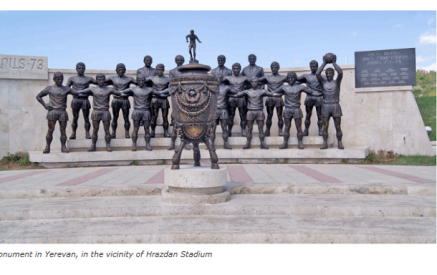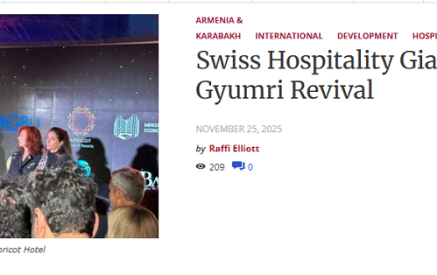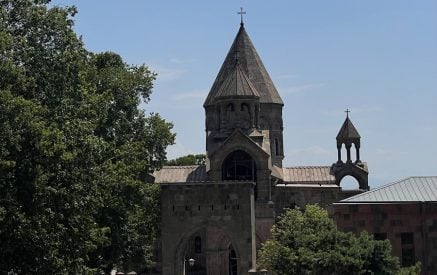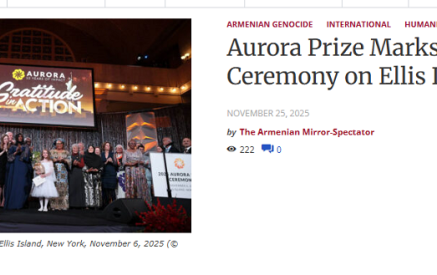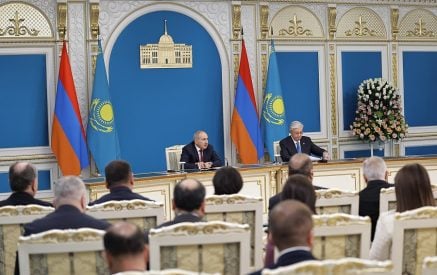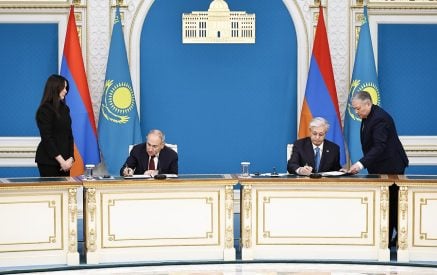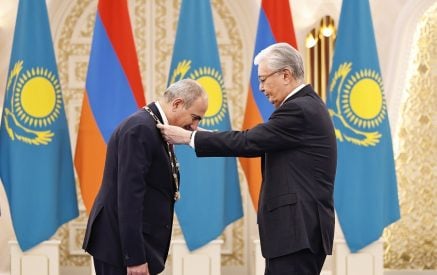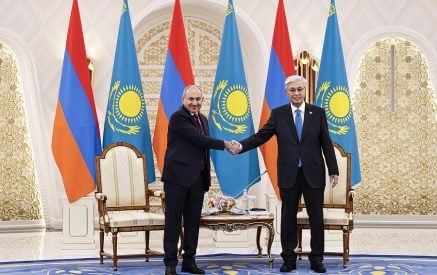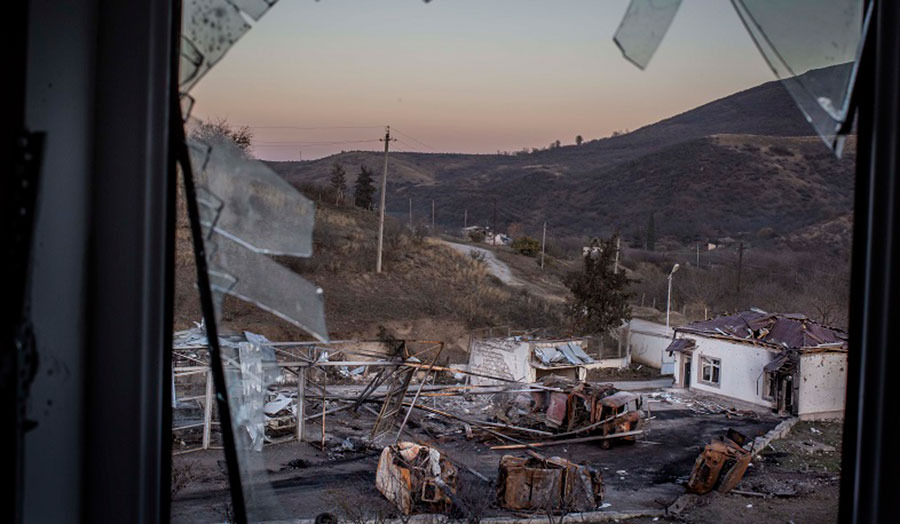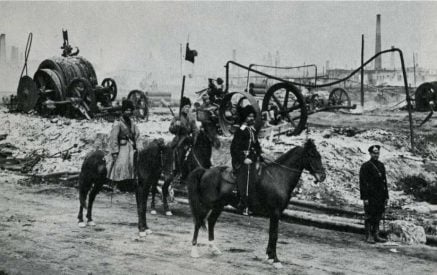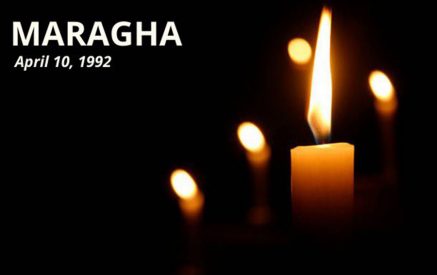By Gayane Barseghyan
Between 1905 and 1921 horrific massacres were committed against Armenians by Azeris (Tatars) in the Armenian Highland and Transcaucasia.
The internationally recognized term “Armenian Highland” was introduced by Otto Wilhelm Herman von Abich, a German mineralogist and geologist, in his three-volume book Geologische Forschungen in den Kaukasischen Landern (3 vols, Vienna, 1878, 1882, 1887). According to Encyclopedia Britannica Armenian highland is a “mountainous region of western Asia. It lies mainly in Turkey, occupies all of Armenia, and includes southern Georgia, western Azerbaijan, and northwestern Iran. The highland covers almost 154,400 square miles (400,000 square km).”
Read also
The Institute for Armenian Studies of Yerevan State University states that “Armenian highland is situated in the northern borderline of Western Asia between Asia Minor and Iranian plateaus, Black Sea and Mesopotamian plains.”
Armenia has been under constant threat ever since the Turkic tribes from Middle Asia set foot on the Armenian Highland in the 11th century. In addition to the 1915 Armenian Genocide committed by Ottoman Turkey, Tatars (as Azeris were known then) executed a number of massacres against the Armenian race in the 20th century.
From 1905 to 1921, approximately 270 US press reports from the New York Times, the Boston Globe, the Christian Science Monitor and the Los Angeles Times covered the alarming news of the massacres against Armenians. Those massacres threatened to trigger annihilation and extinction of the whole race.
A book titled Azeri Aggression against Armenians in Transcaucasia (1905-1921), edited by Ara Ketibian (2020), an Australian-Armenian researcher and co-editor of the multi-volume publication The Armenian Genocide: Prelude and Aftermath, lists the US press reports, published namely in the years 1905 (94 reports), 1906 (19 reports), 1910 (2 reports), 1911 (1 reports), 1916 (2 reports), 1918 (46 reports), 1919 (44 reports), 1920 (53 reports) and 1921 (9 reports). The book is an all-inclusive invaluable resource for researchers and historians to dig up facts on massacres committed against Armenians in the 20th century.
“Over the period from 1905 until 1921, there have been continuous flare ups of aggression, murders and wholesale massacres of Armenians by Tatars (as Azeris were known then). In some cases, this aggression simply took the form of general localized conflicts between the two communities in many cities, towns and even villages,” the Preface of the afore-mentioned book maintains.
On visiting the Armenian Genocide Museum-Institute on February 19, 2023 Ara Ketibian stated that “although the means of physical hostility against the Armenian people have changed over time and have become more lethal, Turkey’s Pan-Turanian plan, at the expense of the Armenian people, has remained unchanged over the last 100 years.”
It is worth stating at this point that massacres against Armenians were committed by Azeris not only in the period of 1905-1921, but also from 1988 to 1994, namely Baku massacres (1905, 1918, 1990), Shushi massacres (1905, 1920), Agulis massacres (1919, 1920), Sumgait massacre (1988), Getashen massacre (1991), Shahumyan massacre (1992), Maragha Massacre (1992) and others.
On September 6, 1905, the Chicago Daily Tribune printed an article headlined “Tartars Murder, Burn and Pillage.” The article starts by reporting about Shushi, Baku and other places plunged into chaos. “Tartars are terrorizing the whole of southeast Caucasus. Bands are scouring in the country, murdering and pillaging. The country is in panic and houses and farms are being abandoned. Famine in many sections renders the situation more terrible” the paper reports.
Two days later, on September 8, 1905, another article appeared in the Chicago Daily Tribune headlined “Tartars Massacre 1,500 Armenians.” It starts by informing readers about the massacre, pillage and incendiarism in Baku, providing a detailed account of the evidence obtained by cable.
“The butchery began with the slaughter of 1,500 Armenians while the police looked on as if it were a theatrical display. Women were shockingly mutilated, children were lashed to pieces before their mothers’ eyes. Men either were cut to pieces instantly or mutilated in an indescribable fashion before they were put to death. An Armenian vizier, who barricaded himself in his house, was roasted to death with his wife and children,” the report notes.
Furthermore, the article discusses the number of Armenian civilian casualties as well. Albeit having found refuge in another house, Armenians were persuaded to come out, following which the Tatar soldiers ambushed and murdered them.
On September 7, 1905 the Chicago Daily Tribune article titled “Caucasia Swept by Tartar Horde” reports about the massacre of the entire Armenian village Hak (spelled Mankend in the report). “A dispatch from Elizabethpol says that all of the inhabitants of the Armenian village of Mankend in the district of Zangezursk [sic. Zangezur] have been massacred by Tartar nomads.”
It is notable that the article refers to “Tartar nomads,” thus noting that they were not indigenous in the geographic areas. Moreover, from linguistic point of view, the word “Tatar” literally means “a nomad.”
On September 13, 1905 both the Washington Post and the Chicago Daily Tribune had reports on 300 Armenians killed in one village, providing horrific details of the crimes committed by Tatars.
“Tartar Hordes Massacring the Armenians; Children Thrown to Dogs […] A holy war has been proclaimed in the Caucasus districts of Zangezur and Jebrail, where Tartars are massacring the Armenians without distinction of sex or age. The country is swarming with bands of Tartars under the leadership of their chiefs. Many thousands of Tartar horseman have crossed the Perso-Russian frontier and joined the insurgents in destroying Armenian villages” the Washington Post reports in an article titled “Holy War Proclaimed.”
“Tartars raise the Green Flag as Signal for Armenian Massacres; Kill old and young; Russian Troops Too Busy in Fighting Social Democrats to Protect Christians,” reports the Chicago Daily Tribune in an article titled “Begin Holy War in the Caucasus.”
It is essential to note that Tatars (or Tartars as Azeris were known then) attacked and ravaged not only civilians, but also Armenian monks and holy sites. On July 13, 1906 the Chicago Daily Tribune printed an article titled “Tartars Attack Monks; Furious Onslaught on Armenian Monastery.” It informs about the attack on Echmiadzin monastery and the residence of the Armenian patriarch, on one village in Zangezur and the city Van.
Having concealed in the surrounding hills, Tatars had ambushed Armenian monks and opened fire after nightfall. Moreover, in Zangezur Tatars had attacked an Armenian village. “In the Zangisur [sic. Zangezur] district today 300 Tartars attacked one Armenian village. A detachment of police arrived and tried to restore peace, but the Tartars killed the police captain,” the Chicago Daily Tribune reports.
On July 31, 1919 both the Chicago Daily Tribune and the Washington Post periodicals reported about Turkey-backed Tatar attack on Armenians from three sides, cutting off the relief supplies.
Next, the US media coverage reveals that the brutal suppression, fire opening and attack on Armenians lasted till the end of the year 1919.
On December 9, 1919, the Los Angeles Times issued another article titled “Armenia Again is Involved in War: Azerbaijan headed by Turkish Officers, Attack on Three Sides.” It reports about triple attack on 12,000 Armenians from three sides – Meghri, Nakhichevan and Stepanakert. It goes without saying that trying to plunge the country into chaos and turning it into a war-torn country, Azerbaijan clearly aimed at territorial gain.
Of special significance is the Christian Science Monitor article issued on August 28, 1919, titled “Tartars and Kurds Slay Armenians.” It reports about the 600 civilian casualties (men, women, children) in Artsakh/Nagorno Karabakh and the destruction of six Armenian villages. This report poses a paramount importance in terms of demographic data of Artsakh population where Armenians made up the majority in 1919 as well.
“According to the pre-war statistics of the Russian Government, Armenian Karabakh (the occidental half of the administration of Cantzak) numbered a total population of 526,000 inhabitants, of whom 376,000 were Armenians, 138,000 Tartars, 9000 Russians, Georgians, etc., and 3000 Turks” the Christian Science Monitor reports.
Furthermore, the Christian Science Monitor report clarifies the reasons behind the massacre of Armenians. “The cause of the trouble is said to be apparently political dues to the desire of the Tartars to annex the Armenian Province of Karabakh to the Tartar Republic of Azerbaijan.”
On March 26, 1920 the New York Times printed a press report headlined “17,000 Armenians Massacred by Tartars, Declares Prelate on Mission to Allies.” Similarly, another report appeared in the Boston Globe, headlined “Reports 17,000 Armenians Slain by Tartars Recently.” Both reports cited the data obtained from Armenian Archbishop Khoren, who had arrived in London from Yerevan.
On April 22, 1921 the Christian Science Monitor issued an all-inclusive article titled “Fierce Attacks on Armenians,” reporting about the “slaughter and devastation charged to Tartars and Bolsheviki in Near East Dispatches.” It provides a detailed account of the fifth time invasion by Bolsheviks and Tatar devastation. The report reveals that Bolsheviks fiercely attacked Armenians in Spitak and surrounding villages. In Dilijan and Vanadzor Armenian intellectuals and household names were executed, namely Nerses Avakian, deputy Allabekian, president of Zemstovo and others. It should be noted that some Armenian place names were spelled differently in the report, utilizing the place names in use at that period of time.
The above-mentioned Christian Science Monitor April 22, 1921 report also indicates the predominance of Bolsheviks in the Tatar-Bolshevik overlapping actions against Armenians which might trigger irreversible dire consequences.
“Bolsheviki are exciting the Tartars against the Armenians for the purpose of starting armed conflict between the two populations. Armenian peasants are defending themselves heroically, but Russian soldiers continue to aid Bolsheviki bands. Annihilation of Armenian people seems inevitable” the Christian Science Monitor reports.
Last but not least, on November 22, 1921 a succinct article appeared in the New York Times titled “New State of Nakhichevan.” The article informs about the unfortunate treaty signed in Kars on October 13, which resulted in territorial gains for Turkey and Azerbaijan.
“The treaty creates within Armenian territory the small autonomous State of Nakhichevan, under the protection of the Republic of Azerbaijan. About half of Caucasian Armenia is given to the Turks as well as large tracts of territory in Georgia. The preamble of the treaty recognizes the rights of peoples to self-determination” the New York Times reports.
(Gayane Barseghyan is a lecturer at Brusov State University, Yerevan in the Department of Linguistics and Professional Pedagogy. The scope of her research comprises studies in Linguistics and Romano-Germanic Philology.)



